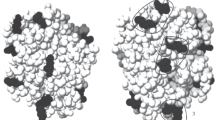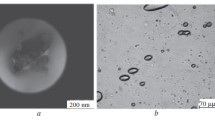Abstract
EPR studies of a nitroxide spin label and of the nitroxide spin-labeled albumin entrapped in cellulose triacetate fibers were carried out.
The EPR spectra have shown that within the fiber only two phases are present: a liquid one of medium viscosity trapped inside microcavities, and a polymeric one surrounding them.
After entrapment, spin-labeled albumin is distributed mainly in the liquid phase, though a not negligible amount of it remains within the polymeric matrix.
The EPR studies have shown that, after the standard procedure of drying, the albumin is almost completely precipitated, but about 85% of it returns to solution when the fiber is again placed in the solution.
The behavior of the albumin dissolved inside the microcavities toward denaturating agents and pH change, and that of the free albumin in solution is similar; the minor differences noticed indicate a second-order interaction between the fiber and the protein.
Similar content being viewed by others
References
Zaborsky, O. R. (1973), inImmobilized Enzymes, CRC Press, Cleveland, Ohio.
Katchalski, E., Silman, I., and Goldman, R. (1971),Advan. Enzymol. 34, 445.
Goldstein, L., and Manecke, G. (1976), inJ. Solid-Phase Biochemistry 1, 23.
Lynn, M. (1975), inEnzymology, Vol. 1, Marcel Dekker, New York, p. 7.
Marconi, W., and Morisi, F. (1979), inApplied Biochemistry and Bioengineering, Vol. 2, Academic Press, New York.
Dinelli, D. (1972),Process Biochem. 7(8), 9.
Dinelli, D., Marconi, W., and Morisi, F. (1976), inMethods in Enzymology, Vol. 44, Academic Press, New York, p. 227.
Stone, T. J., Buckam, T., Nordio, P. L., and McConnell, H. M. (1965),Proc. Natl. Acad. Sci. US 54, 1010.
Grigorian, G. L., Kalmanson, A. E., Rozantzev, E. G., and Suskina, U. S. (1967),Nature,216, 927.
Sands, R. H. (1955),Phys. Rev. 99, 1222.
Kneubuhl, T. K. (1960),J. Chem. Phys.,33, 1074.
Kivelson, D. (1960),J. Chem. Phys. 33, 1904.
Griffth, O. H., and McConnell, H. M. (1966),Proc. Natl. Acad. Sci. US 55, 8.
Kornberg, R. D., McConnell, H. M. (1971),Biochemistry 10, 1111.
Kornberg, R. D., McConnell, H. M. (1971),Proc. Natl. Acad. Sci. US 68, 2564.
Yang, J. T., and Foster J. F. (1954),J. Amer. Chem. Soc. 76, 1588.
Herrington, W. F., Johnson, P., and Ottewil, R. H. (1956),Biochem. J.,62, 569.
Author information
Authors and Affiliations
Rights and permissions
About this article
Cite this article
Gulinelli, S., Mantovani, E. & Zanobi, A. EPR characterization of cellulose triacetate fibers used for enzyme immobilization. Appl Biochem Biotechnol 6, 129–141 (1981). https://doi.org/10.1007/BF02779245
Received:
Accepted:
Issue Date:
DOI: https://doi.org/10.1007/BF02779245




